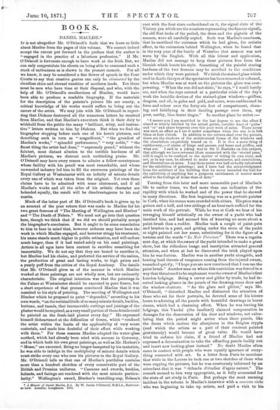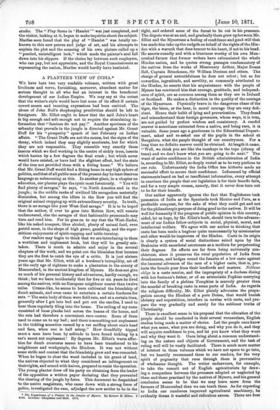BOOKS.
DANIEL MACLISE.* IT is not altogether Mr. O'Driscoll's fault that we learn so little about Maclise from the pages of this volume. We cannot indeed accept the excuse put forward in the preface that the author is "engaged in the practice of a laborious profession." If Mr. O'Driscoll is fortunate enough to have work at the Irish Bar, we can only congratulate his clients on being able to command such a stock of enthusiasm as is shown in the present memoir. For all we know, it may be considered a fine flower of speech in the Four Courts to say that creative genius can only be eliminated by the cloudless skies and eternal sunshine of southern lands. Yet there must be men who have time at their disposal, and who, with the help of Mr. O'Driscoll's recollections of Maclise, would have been able to produce a readable biography. If the materials for the description of the painter's private life are scanty, a critical knowledge of his works would suffice to bring out the career of the artist. We may join with Mr. O'Driscoll in regret- ting that Dickens destroyed all the numerous letters he received from Maclise, and that Maclise's executors think it their duty to withhold from the public the many "brilliant, witty, and instruc- tive" letters written to him by Dickens. But when we find the biographer stopping before each one of his hero's pictures, and describing each in turn as "magnificent," "the grandest of Maclise's works," "splendid performance," "very noble," "the finest thing the artist had done," "supremely grand," without the faintest, most distant allusion to the terrible hardness of all Maclise's pictures, we distrust such unthinking praise. Mr. O'Driscoll may have every reason to admire a fellow-countryman whose facility with his pencil was most remarkable, and whose unwearied industry led him to fill the enormous paintings of the Royal Gallery at Westminster with an infinity of minute details every one of which was taken from the original. Yet even these claims have to be admitted with some abatement, and if all Maclise's works and all the sides of his artistic character are belauded equally, the result will be disadvantageous to his real merits.
Much of the latter part of Mr. O'Driscoll's book is given up to an account of the poor return that was made to Dfaclise for his two great frescoes of "The Meeting of Wellington and Blucher" and "The Death of Nelson." We need not go into that question here, though we think that if we did we should probably accept the biographer's conclusion. But it ought to be some consolation to him to bear in mind that, however arduous may have been the work in which Maclise engaged, and however stingy his treatment, his name stands much higher in public estimation, and will endure much longer, than if it had rested solely on his easel paintings. Artists in all ages have been content to sacrifice something for immortality. We do not say that they are bound to sacrifice it, but Maclise had his choice, and preferred the service of the nation, the production of great and lasting works, to high prices and a yearly puff from the critics of the Royal Academy. The details that Mr. O'Driscoll gives us of the manner in which Maclise worked at these paintings are not wholly new, but are eminently characteristic. The original intention was that the paintings in the Palace at Westminster should be executed in pure fresco, but a short experience of that process convinced Maclise that it was unsuited to his style of painting. The meeting of Wellington and Blucher which he proposed to paint "depended," according to his own words, "on the verisimilitude of so many minute details, buckles, buttons, and tassels, that innumerable cuttings and joinings of the plaster would be required, as a very small portion of these details could be painted on the fresh-laid plaster every day." He expressed himself disheartened at the difficulties of fresco, which "confined the artist within the limits of the applicability of very scant materials, and made him doubtful of their effect while working with them." For these reasons MacRae adopted the water-glass method, which had already been tried with success in Germany, and in which both his own great paintings, as well as Mr. Herbert's "Moses," are executed. Being no longer hampered by his materials, he was able to indulge in the multiplicity of minute details which must strike every one who sees his pictures in the Royal Gallery. Mr. O'Driscoll tells us that one of Maclise's portfolios contains more than a hundred sketches of every conceivable part of the British and Prussian uniforms. "Cannons and swords, buckles, helmets, and facings are rendered with the most minute particu- larity." Wellington's sword, Blucher's travelling-cap, Nelson's
• A Memoir of Dante 1 Marlin, B.A. By W. Justin O'Driscoll, ILILLA., Barrister- et Law. London: Longtnans. 5871.
coat with the four stars embroidered on it, the signal slate of the Victory (on which are the numbers representing the famous signal), the old flint locks of the period, the dress and the pigtails of the seamen, were all carefully copied. Such was Maclise's exactness, that he sacrificed the cuirasses which he had given, for artistica effect, to the cuirassiers behind Wellington, when he found that in the very year of the battle of Waterloo that armour was not worn by the English. With all this labour and application,.
Medias did not manage to keep these pictures free from the- blemish which besets his style. Something of the painful staring hardness of the two frescoes may be ascribed to the conditions- under which they were painted. We think the stained glass whicla used to dazzle the eyes of the spectators has been removed or softened,. but when Maclise was at work on the pictures the glare was over- powering. "When the sun did not shine," he says, "I could barely see, and when the rays entered at a particular crisis of the day's.
work the heraldic devices of the stained-glass windows—griffins,. dragons, and all, in gales and gold, and azure, were emblazoned in, form and colour over the forty-six feet of compartment, sham- ing and falsifiying in their dazzling passage over them, my poor, earthy, lime-burnt tinges." In another place he writes :—
" I assure you I am mortified in the last degree to see the effect I aimed at utterly falsified by the actual garish, heraldic hues of ' gales' and ' or ' and azure besprent over this poor work of mine. There never was such an effect as I see it under sometimes when the sun is in full blaze at four o'clock. In addition to the colours shed over the picture, there are the shadows of the architectural forms of the windows and the chandeliers exquisitely traced on it. It is Men a mere thing of emblazonry,—of stains of kings and queens, and boars and griffins, and what not. I said in a joking way to Sir C. Eastlake on this subject,. that although we have reverent ideas connected with the storied pane,' still it ought to be confined to the matter of telling its own story, and not, as in my case, be allowed to make commentaries, and annotation,. and illustrations on mine. I say there never was hall so badly calculated for the exhibition of paintings; and I have had the acknowledgment from the architect of the building that he never intended the hall for the exhibition of anything but a gorgeous enrichment of matter more allied to the College of Arms than of Arts."
Turning from this later and more memorable part of Maclise's life to earlier times, we find more than one indication of the. rapidity with which he worked and of the power that he showed in many directions. His first beginning was as a portrait-painter in Cork, when his rooms were crowded with sitters. His price was a guinea and a half, and two sittings of an hour each sufficed for the main work of the portrait. While he was at Cork we hear of his. revenging himself artistically on the owner of a yacht who had insulted him, and had accused him of knowing no more about ta paint-brush than a rudder. Maclise took a couple of paint-pots and brushes in a punt, and getting under the stern of the yacht. atnight painted out her name, substituting for it the figure of tortoise and the words "Le Noir Fainéant." There was a regatta. next day, at which the owner of the yacht intended to make a great. show, but the ridiculous image and inscription attracted general attention, and when at last he discovered the trick played upon him he was furious. Maclise was in another yacht alongside, and hearing loud threats of vengeance coming from the injured owner, remarked quietly, "I hope you are now convinced that I can use the' paint brush." Another man on whom this conviction was forced in a, way that threatened to be unpleasant was the owner of Maclise's first, London lodgings. Being a carver and gilder by trade, he had in- serted looking-glasses in the panels of the drawing-room door and the window-shatters. "As the glare and glitter," says Mr.. O'Driscoll, "disturbed Maclise and distracted the attention of those who sat for their portraits, he devoted some of his leisure. hours to adorning all the panels with beautiful drawings in burnt sienna, which had a charming effect. When he was leaving his. lodgings, this Vandal (the landlord) claimed compensation in damages for the desecration of his door and windows, not calcu- lating that the period might arrive when these panels, like the doors which enclose the altarpieces in the Belgian crypts (and which the artists as a part of their contract painted gratuitously) would become of great value. He would have tried to enforce his claim, if a friend of Maclise had not, expressed a determination to take the offending panels bodily out and insert new looking-glass instead." No doubt MacRae often, came in contact with people who were equally ignorant of every- thing connected with art. In a letter from Paris he mentions. that while in the Louvre he took one or two sketches of those who were copying the pictures, but he was courteously informed by an attendant that it was " defendu d'etudier d'apres nature." The remark seemed to him very appropriate, as it fully accounted for the state of art study in Paris. But perhaps the most amusing incident in the volume is Maclise's interview with a nouveau riche who was beginning to take up artists, and paid a visit to his studio. The "Play Scene in Hamlet ' " was just completed, and the visitor, looking at it, began to make inquiries about the subject. Maclise soon found that the play of " Hamlet " was totally un- known to this new patron and judge of art, and his attempts to explain the plot and the meaning of his own picture called up a "puzzled, unintelligent look," which made the painter's soul fall down into his slippers. If the choice lay between such employers, who can pay, but not appreciate, and the Royal Commissioners as representing the nation, Maclise would hardly have hesitated.



































 Previous page
Previous page